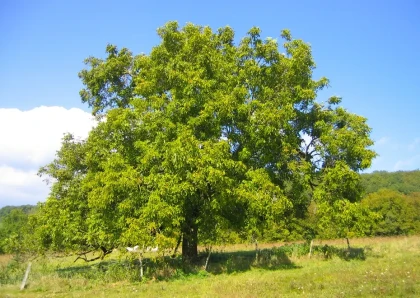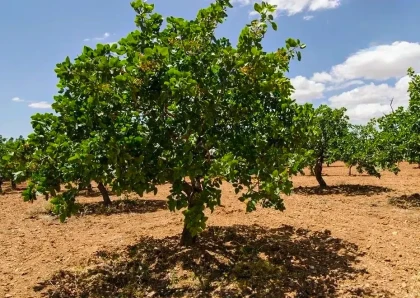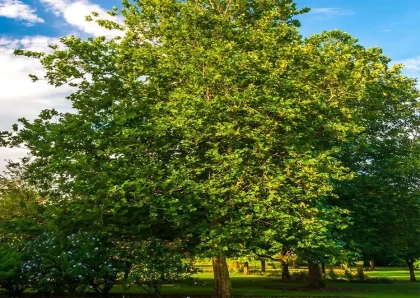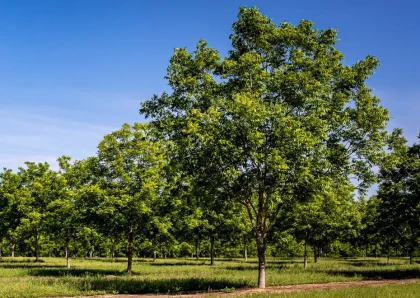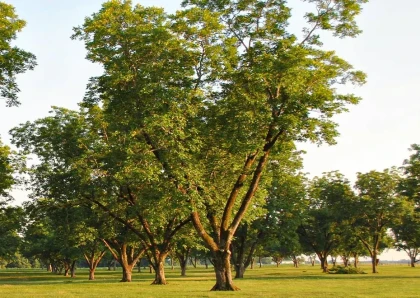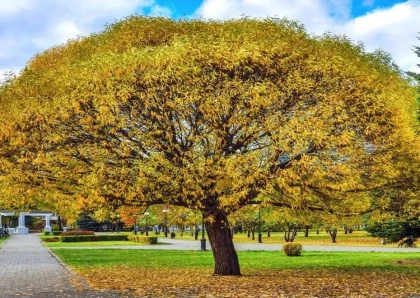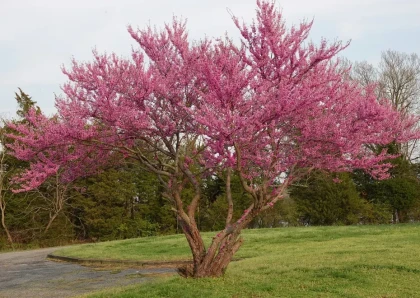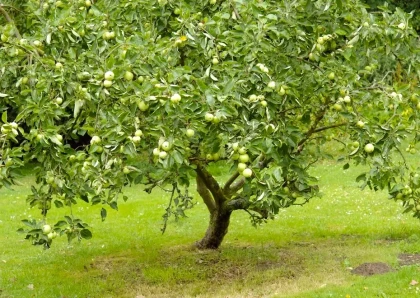
E H Wilson Mimosa Tree
Overview
The E H Wilson Mimosa Tree, scientifically known as Albizia julibrissin 'E.H. Wilson,' is a captivating addition to any landscape with its exceptional ornamental features and adaptability. This tree is often referred to as the "Silk Tree" due to its intricate, feathery flowers that create a stunning floral display reminiscent of delicate silk fabric.
The tree traces its roots back to China and pays tribute to the famed plant explorer, Ernest Henry Wilson. It was Wilson who introduced the tree to the Western world after his botanical explorations in Asia during the early 20th century. In recognition of his contribution, this particular variant of the Mimosa tree bears his name.
Standing tall at a height of 20 to 40 feet when fully matured, the E H Wilson Mimosa tree creates an impressive sight. This tree has an expansive, umbrella-like canopy filled with bright green, fern-like leaves, providing a generous shade area beneath. The tree blooms in the summer, revealing clusters of showy, fragrant pink flowers, which serve as a nectar source for bees and butterflies. This contributes to the tree's reputation as a wonderful choice for nature-friendly landscaping.
Beyond its aesthetic appeal, the E H Wilson Mimosa tree also boasts hardiness. It is capable of thriving in a variety of soil conditions, ranging from clay, sandy, to loamy soils, and can tolerate both acidic and neutral pH levels. In terms of climate, it flourishes in USDA hardiness zones 6 to 9, showing an ability to withstand lower temperature extremes.
Types of E H Wilson Mimosa Tree
There's mainly one type of E H Wilson Mimosa tree available in the market. It's defined by its distinct characteristics, such as bright green, fern-like foliage, intricate pink flowers, and the ability to thrive in USDA hardiness zones 6-9.
Wood Products from E H Wilson Mimosa Tree:
The wood of the E H Wilson Mimosa tree is generally soft and lightweight, making it unsuitable for heavy-duty wood products. However, it can be utilized for smaller items, such as ornamental crafts or small furniture pieces. It's also used in landscaping due to its decorative appeal.
Benefits of E H Wilson Mimosa Tree
- Visual Appeal: The E H Wilson Mimosa tree offers a grand visual spectacle with its feathery pink blooms and fern-like green foliage. Its unique appearance makes it a standout feature in any landscape.
- Rapid Growth: One of the most impressive features of this tree is its rapid growth rate. This makes it an excellent choice for individuals who wish to quickly enhance their landscape or add an element of maturity.
- Versatile: This tree shows great adaptability, thriving in various soil conditions ranging from clay, sandy, to loamy soils. It can tolerate both acidic and neutral pH levels.
- Drought-tolerant: Once established, the E H Wilson Mimosa tree becomes highly drought-tolerant. This makes it a suitable choice for areas prone to dry conditions.
- Pest Resistant: The tree displays a natural resistance to most pests, which decreases its maintenance demands and ensures it remains a healthy and vibrant part of your landscape.
- Attracts Wildlife: The fragrant, bright flowers of the tree attract a variety of pollinators, including bees and butterflies. This can help promote a healthier ecosystem in your garden.
- Shade Provider: Thanks to its wide, umbrella-like canopy, the E H Wilson Mimosa tree is an excellent shade provider. This makes it a suitable addition near patios or outdoor seating areas.
- Adaptable: The E H Wilson Mimosa tree can flourish in USDA hardiness zones 6 to 9, showing an ability to withstand lower temperature extremes, thus making it adaptable to various climates.
Cons of E H Wilson Mimosa Tree
- Invasiveness: Given its rapid growth and self-seeding habit, the E H Wilson Mimosa tree can sometimes be considered invasive. It can quickly overtake native plants in certain regions, disrupting the local ecology.
- Susceptibility to Disease: Despite its overall hardiness, the tree can be susceptible to a specific fungal disease known as Mimosa Vascular Wilt. This disease can cause wilting and death of branches, and in severe cases, can lead to the tree's demise.
- Messiness: The tree produces a considerable amount of litter, including leaves, flowers, and seed pods, which might require regular cleanup.
Tips for Planting and Maintaining E H Wilson Mimosa Tree
Plant your E H Wilson Mimosa tree in a well-drained area with full to partial sunlight. The tree isn't too picky about soil but prefers neutral to acidic pH levels. Regular watering during the first year will help establish the tree, after which it becomes highly drought-tolerant. Pruning should be done in late winter to keep the growth in check and maintain the tree's shape.
Conclusion
The E H Wilson Mimosa Tree is a remarkable choice for any landscape due to its distinct, feathery blooms, and adaptability to various conditions. While the tree does have a few cons, with proper care and maintenance, it will add a unique charm to your space.
FAQs
- Is the E H Wilson Mimosa Tree evergreen?
- How often should I water my E H Wilson Mimosa Tree?
- Is the E H Wilson Mimosa Tree suitable for small gardens?
- How fast does the E H Wilson Mimosa Tree grow?
No, the E H Wilson Mimosa is a deciduous tree, meaning it loses its leaves in fall and winter.
Regular watering is essential during the first year. After that, the tree becomes drought-tolerant and requires minimal watering.
Given its mature size, the E H Wilson Mimosa tree might not be the best fit for small gardens. However, with regular pruning, you can maintain its size.
The E H Wilson Mimosa Tree is known for its rapid growth. It can reach its full size within a few years, especially in favorable conditions.
No listings available
Related Products
Early Elberta Peach
Early Elberta Peach is a highly sought-after peach tree variety that stands out for its remarkable taste and ability to yield fruit earlier than...
Kwik-Krop Walnut Tree
History of the Tree The Kwik-Krop Walnut Tree has a rich history that dates back many decades. Developed by renowned horticulturist Dr. John A....
Famosa Pistachio Tree
History of the Tree The Famosa Pistachio Tree, scientifically known as Pistacia vera 'Famosa,' is a revered variety of pistachio tree with a fascinating...
Columbia Sycamore Tree
Certainly! The Columbia Sycamore Tree (Platanus x acerifolia 'Columbia') is a majestic and highly sought-after deciduous tree. It is a hybrid of the American...
Hardy Giant Pecan Tree
History of the Tree The Hardy Giant Pecan Tree, scientifically known as Carya illinoinensis 'Hardy Giant,' is a remarkable pecan tree variety with a...
Barcelona Filbert Hazelnut Tree
History of the Tree The Barcelona Filbert Hazelnut Tree, also known as Corylus avellana 'Barcelona,' is a popular cultivar of the European hazelnut tree....
Pawnee Pecan Tree
History of the Tree The Pawnee Pecan is a notable pecan tree variety that was developed by researchers at the USDA Agricultural Research Service....
Globe Navajo Willow Tree
The Globe Navajo Willow Tree, scientifically known as Salix matsudana 'Navajo,' is a popular deciduous tree known for its unique and appealing characteristics. This...
Eastern Redbud
The American Redbud Tree (Cercis canadensis) is a charming and versatile deciduous tree that is native to eastern North America. It is widely admired...
Granny Smith Apple Tree
History of the Tree The Granny Smith Apple Tree is a renowned apple variety that originated in Australia in the 1860s. It was discovered...
Questions & Answers
What do you want to know about this product?
Reviews (5)
TreeHugger42
A Royal Touch to Your Landscape
The E H Wilson Mimosa tree was the perfect addition to our property. Its feathery blooms and vibrant foliage really up the ante on curb appeal. Fast growth and drought tolerance are a bonus.
RootEnthusiast77
A Unique Tree with a Heart to Survive
Planted our E H Wilson Mimosa tree last spring. It's proved to be a tough contender, surviving a rough drought with ease. Blooms are a summer delight!
GreenThumb89
Garden's Showstopper
The E H Wilson Mimosa tree's flowers have made my garden a paradise for pollinators. Its fast growth and adaptability to our soil were surprising. A true showstopper!
SaplingSavvy53
A Tree of Joy, But Watch the Litter
E H Wilson Mimosa tree is beautiful and sturdy, but its litter can be a bit much. Weekly cleanup necessary, but the splendid blooms make it worth the effort!
BarkBeast34
Rapid Growth, Excellent Shade Provider
Impressed with E H Wilson Mimosa's growth rate. Its broad canopy offers great shade, ideal for our outdoor reading nook. A bit invasive, but manageable with regular care.






